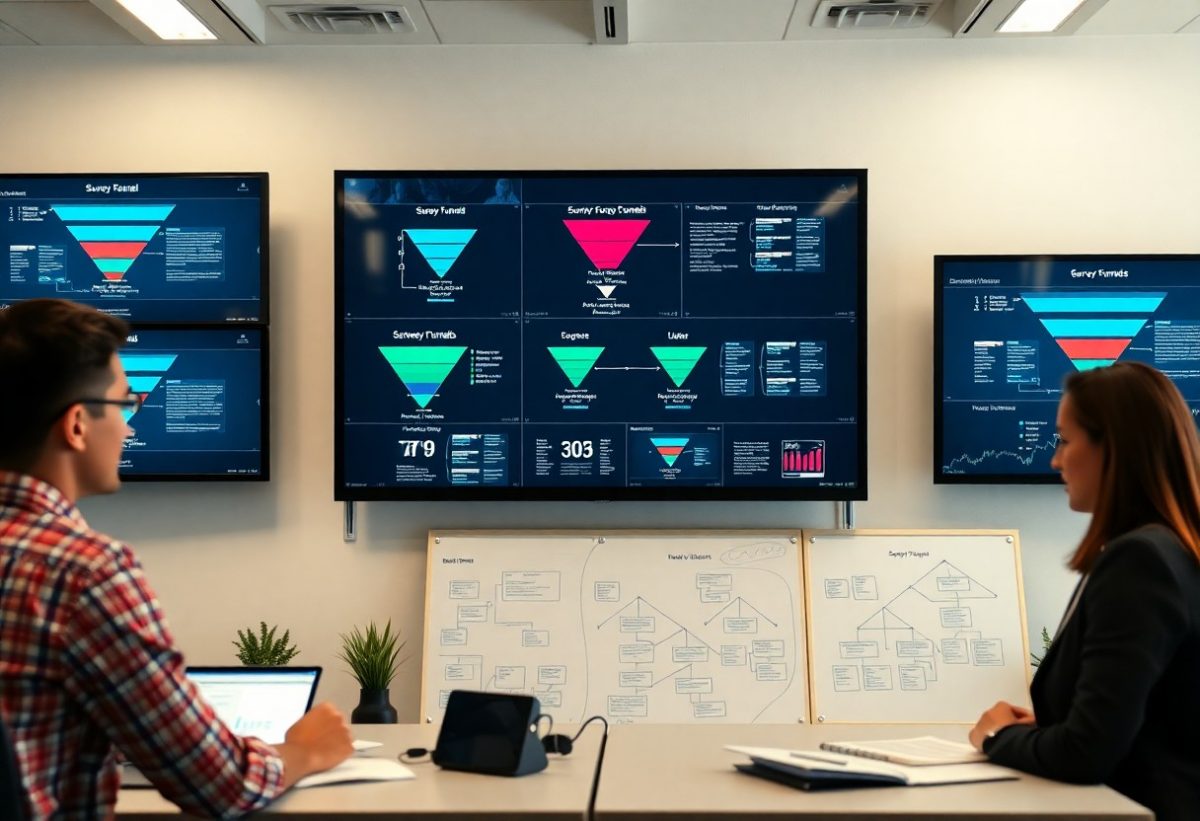Many businesses struggle to create personalized experiences that truly engage their audience. With the new Feature Release Survey Funnels and Branching, you can now build dynamic, interactive surveys that guide your users through tailored paths based on their responses. This powerful tool allows you to embed surveys within marketing funnels and courses, enabling you to capture qualified leads and adapt content to individual needs. By leveraging branching logic, you create customized journeys that improve engagement and conversion, making your marketing and educational efforts more effective than ever before.
Key Takeaways:
- Zenler’s Survey Funnels integrate interactive surveys directly into marketing funnels, enabling real-time lead qualification and segmentation.
- Branching logic allows personalized survey, quiz, and course experiences by guiding users through tailored paths based on their responses.
- The feature supports adaptive learning by customizing course content and quizzes according to each student’s knowledge and interests.
- Starting with a simple survey plan—three questions and two or three result pages—helps users gradually build complexity while mastering the tool.
- Advanced customization options include custom Welcome and Result Pages for a branded and engaging survey experience, with extensive testing and automation capabilities.

Transforming User Interaction with Survey Funnels
Survey Funnels revolutionize how you engage with your audience by shifting interactions from passive to highly interactive and personalized experiences. With Zenler, you’re able to guide users seamlessly through tailored paths based on their responses, increasing relevance and connection. This adaptive approach not only boosts completion rates but also helps you gather meaningful insights to refine your marketing and course strategies. Each step feels more like a conversation than a questionnaire, making your audience more invested and boosting overall conversions.
The Impact of Personalized Marketing Strategies
Personalized marketing through Survey Funnels lets you segment leads in real time, sending users to offers that truly match their interests or needs. Businesses using branching surveys report up to 30% higher engagement because users receive content and calls-to-action tailored precisely to them. By adapting messaging and next steps dynamically, you reduce drop-offs and increase customer lifetime value, turning leads into loyal, satisfied clients.
Designing User Journeys Through Dynamic Surveys
Dynamic surveys enable you to craft customized user journeys that respond organically to each answer. By plotting questions that branch logically based on responses, you provide a relevant, streamlined path for every survey taker. This approach supports nuanced data collection and delivers personalized result pages or follow-up actions, all crafted to resonate deeply with your audience segments.
Diving deeper, designing these user journeys involves careful mapping of decision points where user responses determine subsequent questions or content. For example, a fitness coach might ask if a user exercises regularly; an affirmative leads to questions about workout preferences, while a negative response might open up beginner-friendly resources. This structure reduces friction and keeps users engaged by only presenting relevant questions and outcomes. The result is a survey funnel that not only collects data but also enriches the user experience, converting engagement into actionable marketing or educational steps.
The Four-Faceted Approach of Zenler’s Features
Zenler’s Survey Funnels combine four powerful capabilities into one smooth system: embedding interactive surveys in marketing funnels, applying branching logic to guide users dynamically, adapting course content based on survey inputs, and creating quizzes that respond intelligently to answers. This integrated approach lets you qualify leads more effectively, personalize learning journeys, and increase engagement across your entire platform. By leveraging these four facets together, you produce tailored experiences that resonate with your audience at every touchpoint, ensuring meaningful interaction and higher conversion rates.
Integrating Surveys Directly into Marketing Funnels
Embedding surveys straight into your marketing funnels lets you gather real-time insights while segmenting and qualifying leads as they interact. You can ask targeted questions that funnel respondents toward the most relevant offers or resources, eliminating generic paths. For example, capturing preferences or challenges upfront enables you to adjust follow-up communications automatically, generating higher quality leads and improving conversion by directing prospects to personalized next steps tailored to their responses.
Leveraging Branching Logic for Enhanced Engagement
Branching logic transforms static surveys into dynamic journeys, where each answer determines the next question or result page. This ensures every respondent experiences a tailored path aligned with their interests or needs, boosting engagement and reducing drop-off. For instance, if a user expresses interest in digital marketing, you can direct them to deeper, niche questions about SEO or social ads, while others might receive foundational content, making your funnel responsive and user-focused.
With branching logic, you structure multiple conditional routes that reflect diverse customer profiles, allowing nuanced qualification and segmentation. This multi-path approach enables you to address specific pain points or goals through personalized questions, guiding users efficiently to solutions or offers that solve their unique challenges. By minimizing irrelevant content and maximizing relevance, you foster deeper user interaction and increase the likelihood of conversions or course completions.
Adapting Course Content Through Branching Surveys
Branching surveys within your courses let you tailor the learning experience to each student’s knowledge, preferences, and progress. Instead of a one-size-fits-all curriculum, learners receive customized content pathways that skip basics for advanced students or offer additional resources for those needing support. This approach not only improves learner satisfaction but also enhances retention and outcomes by meeting students exactly where they are.
Applying branching surveys inside courses provides a responsive framework where students’ answers dynamically determine the lessons they encounter next. For example, a survey revealing mastery of foundational topics allows you to automatically unlock advanced modules, while those indicating gaps can receive targeted remedial materials. This adaptive learning method reduces frustration, speeds up progress, and helps you deliver a more personalized education that aligns with each student’s goals and pace.
Crafting Your First Branching Survey: A Practical Guide
Creating your first branching survey in Zenler combines planning precision with easy-to-use tools. Focus on a simple structure initially—three key questions and tailored result pages—so you can get hands-on experience without feeling overwhelmed. This approach lets you learn Zenler’s branching logic smoothly, test various pathways, and refine the user journey. With each iteration, your surveys become more dynamic, engaging, and personalized, unlocking new ways to connect with your audience and deliver targeted content and offers.
Planning Your Survey: The Foundation of Success
Start by mapping your survey’s flow on paper or Canva, detailing each question, possible answers, and where each path leads. For example, a fitness survey might branch off after asking if the participant exercises regularly, directing respondents toward tailored advice or product recommendations. Keeping your initial plan small helps maintain clarity and ensures your logic stays coherent as you build. This upfront work shapes a smooth user experience and sets the stage for seamless branching within Zenler.
Building and Testing Your Survey in Zenler
Once your plan is clear, translate it into Zenler by adding questions and configuring branching paths. Use Zenler’s intuitive interface to assign conditional logic, making sure each answer leads to the right follow-up question or result page. Testing every route is vital: walk through each possible user journey to spot dead ends or unexpected outcomes, verifying that personalized emails and triggers work as intended before launch.
Digging deeper, Zenler lets you customize not just question flows but also welcome and result pages using its drag-and-drop Page Builder. You can create branded, engaging interfaces that reinforce your message at every step. Use test modes to simulate multiple paths, checking if all transitions behave correctly and result pages display relevant content. Testing also reveals if automation sequences, like follow-up emails based on survey outcomes, trigger reliably—ensuring your funnel performs flawlessly from day one.
Launching Your Survey: Automation and Evaluation
With testing complete, launch your survey and connect it to Zenler’s automation workflows. Tailor follow-up emails based on responses to nurture leads or personalize course paths. Regularly monitor survey analytics to identify drop-off points or high-converting branches, enabling continuous improvement. Automated survey funnels become powerful engines for engagement, guiding users dynamically while you focus on strategy.
Beyond launch, evaluate performance through Zenler’s detailed reporting—track completion rates, segment responses, and assess which branches deliver the best ROI. Use these insights to tweak questions, optimize paths, and refine automation sequences. Keeping a close eye on user behavior post-launch helps evolve your surveys into smarter, more effective tools that enhance personalization and drive conversions over time.
Advanced Techniques to Maximize Survey Effectiveness
Leverage advanced methods to elevate your survey funnels beyond basic question flows. Combining branching logic with fully customized welcome and result pages ensures each participant experiences a tailored journey. By systematically testing every path and optimizing message timing, you boost engagement and conversion rates. Integrate follow-up emails based on results to nurture leads effectively and gather actionable insights. Scaling survey complexity thoughtfully while maintaining clarity transforms your funnels into powerful tools driving personalized interaction and stronger audience connections.
- Strategically use branching logic for personalized paths
- Create compelling welcome screens to set expectations
- Design custom result pages aligned with user responses
- Test all routes to ensure seamless user experience
- Automate targeted follow-up emails linked to results
| Technique | Benefit |
| Branching Logic | Delivers personalized and relevant content, increasing engagement |
| Custom Welcome Pages | Captures attention immediately and clarifies survey purpose |
| Custom Result Pages | Provides tailored outcomes that drive conversions and follow-ups |
| Thorough Testing | Ensures flawless navigation and user satisfaction |
| Automated Follow-ups | Nurtures leads efficiently based on individual responses |
Utilizing Branching Logic for Custom Experience
Branching logic lets you craft unique pathways aligned perfectly with each user’s input, enhancing relevance and engagement. By directing users to different questions or results based on their answers, you eliminate one-size-fits-all experiences. For example, someone interested in advanced skills can skip foundational content, while beginners receive tailored support. This logic sharpens your funnel’s focus, improving lead qualification and boosting conversion rates with personalized messaging at every turn.
Designing Impactful Welcome and Result Pages
Custom welcome pages set the tone by providing clear context and framing the survey’s value instantly. Utilizing Zenler’s drag-and-drop page builder, you can create compelling introductions that increase completion rates. Similarly, tailored result pages deliver personalized messages, relevant offers, or next-step calls to action that resonate with each user. These pages transform passive respondents into engaged participants primed for conversion and deeper interaction.
Investing effort into welcome and result pages pays dividends through heightened engagement and improved user experience. The welcome page acts as your first impression, offering clarity and motivation, which significantly lowers drop-off rates—surveys with a strong intro see up to 25% higher completion rates. Result pages, on the other hand, extend the relationship by offering personalized recommendations, discount codes, or resource links tied directly to responses, driving follow-through actions. Designing these touchpoints with brand consistency and user psychology in mind turns your survey funnel from a static tool into a dynamic conversion engine.

Practical Applications of Survey Funnels in Various Fields
Survey Funnels with branching logic can be tailored to fit diverse industries, transforming how you engage with your audience. Whether you’re qualifying leads in sales, tailoring content in education, or enhancing customer feedback loops, this tool adapts to your unique needs. By personalizing each interaction based on responses, you create more meaningful connections, boost conversion rates, and deliver relevant outcomes that resonate with your users, improving both engagement and results.
Enhancing Lead Qualification across Industries
Using Survey Funnels, you can effectively segment and qualify leads by asking targeted questions that reveal intent, budget, or timeline. For instance, a B2B company might use branching surveys to discover which product fits a prospect’s needs, immediately directing them to relevant demos or pricing options. This dynamic approach streamlines your funnel, increases lead quality, and reduces manual follow-ups, saving time while boosting conversion rates across sectors like real estate, finance, and healthcare.
Personalized Learning Experiences in Education
Branching surveys empower you to craft adaptive learning paths by assessing each student’s knowledge and preferences. You can identify skill gaps or prior knowledge and immediately redirect learners to content that suits their level, enhancing engagement and retention. This individualized approach transforms your courses into customized experiences, leading to higher satisfaction and better educational outcomes.
For example, in an online language course, you could start with a simple assessment: if a student struggles with verb conjugations, the survey routes them to remedial lessons, while advanced students skip ahead to conversational practice. Schools and training providers have reported up to 30% improvement in course completion rates by dynamically tailoring content this way. Integrating such personalization also allows you to provide timely feedback, offer additional resources, and stay aligned with each learner’s pace—making your courses more effective and responsive to real learner needs.
To wrap up
Summing up, the Survey Funnels and Branching feature release empowers you to create highly personalized, dynamic interactions across your marketing funnels and courses. By guiding users based on their responses, you enhance engagement, lead qualification, and course adaptability. With Zenler’s easy-to-use tools and branching logic, you can start simple and scale complexity as you grow. This innovative upgrade gives you the flexibility to deliver tailored experiences that connect with your audience more effectively than ever before.
FAQ
Q: What exactly are Survey Funnels and Branching in Zenler?
A: Survey Funnels and Branching are new features in Zenler that allow you to embed interactive surveys directly into your marketing funnels and courses. Branching logic enables you to create personalized paths based on users’ answers, making experiences more relevant and adaptive. This means you can qualify leads, segment your audience, and adjust course content dynamically.
Q: How can branching improve my marketing funnels?
A: Branching logic lets you create multiple pathways within your surveys so that participants only see questions relevant to them. For instance, depending on their responses, users can be directed to tailored offers or resources. This personalization helps to better engage your audience and increases conversion rates by providing more targeted experiences.
Q: Can I use Survey Funnels and Branching inside my courses, or is it only for marketing?
A: Yes! Branching is available both within marketing funnels and inside your courses. You can create quizzes and surveys that adapt to each student’s knowledge or interests. For example, if a student demonstrates advanced understanding, the course can automatically skip beginner content and provide more challenging materials, creating a customized learning journey.
Q: What is the best way to start building a branching survey in Zenler?
A: It’s recommended to begin with a simple plan by sketching out your survey flow before building it in Zenler. Start with just a few questions, two or three possible paths, and corresponding result pages. This approach helps you learn the system without overwhelming complexity. After testing and refining the flow, you can add more branches and advanced features.
Q: How can I ensure my Survey Funnels work as expected before launching?
A: Testing is important. Make sure to walk through every possible path of your survey, verify that result pages display correctly, and confirm that any automated emails or actions trigger properly. If you encounter issues or need help, Zenler’s support team is available to assist you with troubleshooting and optimization.

